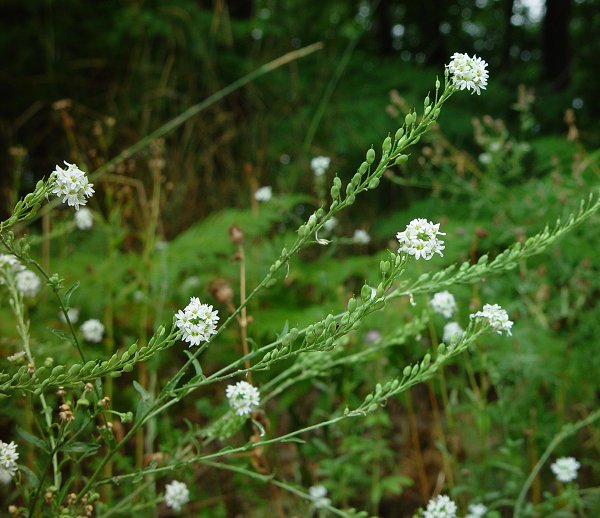Berteroa incana (L.) DC.
Hoary Alyssum

Introduced
CC = *
CW = 5
MOC = 5
© DETenaglia
Berteroa incana (L.) DC.Hoary Alyssum | |
 |
Introduced CC = * CW = 5 MOC = 5 |
© DETenaglia |
|
Family - Brassicaceae Habit - Annual forb. Stems - Ascending to erect, to 1 m, multiple from the base, herbaceous, mostly unbranched below the inflorescence, densely pubescent with stellate, appressed hairs and some unbranched hairs.
Leaves - Alternate, sessile, simple. Blades linear-elliptic to oblanceolate, entire, 1-5 cm long, 1 cm broad, rounded to subacute at apex, reduced upward on stem, densely pubescent with appressed stellate hairs. Inflorescence - Terminal and lateral racemes or panicles, to 25 cm long, dense in flower, quickly elongating in fruit, lower branches subtended by reduced leaves. Pedicels ascending, to 7-8 mm long, pubescent with stellate hairs.
Flowers - Sepals 4, erect, densely stellate-pubescent externally, glabrous internally, 3-4 mm long, to 1 mm broad, with scarious margins, elliptic, acute, deciduous. Petals 4, 5-7 mm long, deeply notched at apex, tapering at base, glabrous. Lobes rounded to acute at apex. Stamens 6, erect, glabrous, white, 3-4 mm long. Anthers yellow, to 1 mm long. Ovary superior, green, densely stellate pubescent, 1 mm long in flower. Style green, to 2 mm long, sparsely stellate-pubescent, persistent in fruit.
Flowering - May - September. Fruits - Silicle 6-7mm long, elliptic-ovate to orbicular, stellate pubescent, beaked, with 6-10 seeds. Beak to 2mm long. Habitat - Roadsides, railroads, waste ground. Origin - Native to Europe. Lookalikes - None close. Other info. - This striking species is rare in Missouri but is becoming more common. The plant is very common in more northern states and is spreading throughout much of eastern North America. The plant is easy to ID in the field because of its deeply divided white petals and gray stellate pubescence. Photographs taken in Marquette, MI., 7-25-02 (DETenaglia); also at Fort Custer Recreation Area, Kalamazoo County, MI, and near Hodenpyl Dam scenic turnout, Wexford County, MI, 7-6-2023 (SRTurner). |